In the following conversation, painters Nicole Eisenman and David Humphrey mention that they once considered, perhaps jokingly, the idea of penning an anti-abstraction manifesto. They never followed up on it. Adopting an adversarial position might have not been in keeping with their belief in communal creative sharing: ultimately, whatever art’s achievements may be as a whole, they are the result of each artist’s individual contributions and benefit everyone.
What is more, proclaiming themselves against abstract art proved unnecessary. In the lapse of the twenty-plus years since Eisenman and Humphrey have known each other—they met in the early 1990s—figuration has been as reappraised and decried as much as abstraction. We’re all the luckier for it, since one of the markers of the current moment in painting is a felicitous syncretism of both strains, as can be seen in their own works and those of many other painters in their cohort.
If the canvas offers a site where previous moments in painting can be revisited and repositioned, both Eisenman and Humphrey also mine the medium’s inherent potential for storytelling, offering two variants: Humphrey is keen on exploring the fictions of the artist elicited by contradictory types of mark-making. His paintings explore those liminal sites where the deeply personal meets the mass-produced, combining the hands-on gestural with slick appropriations of imagery from a range of found sources. Conversely, Eisenman delivers, through the utopias and dystopias she portrays, slant reflections of our contemporary world. She doesn’t set out to do so intentionally, but follows a method more akin to the way the deep subconscious works—manifesting the everyday obliquely, with coded fears and wishes fulfilled, always eschewing logical sense.
— Mónica de la Torre
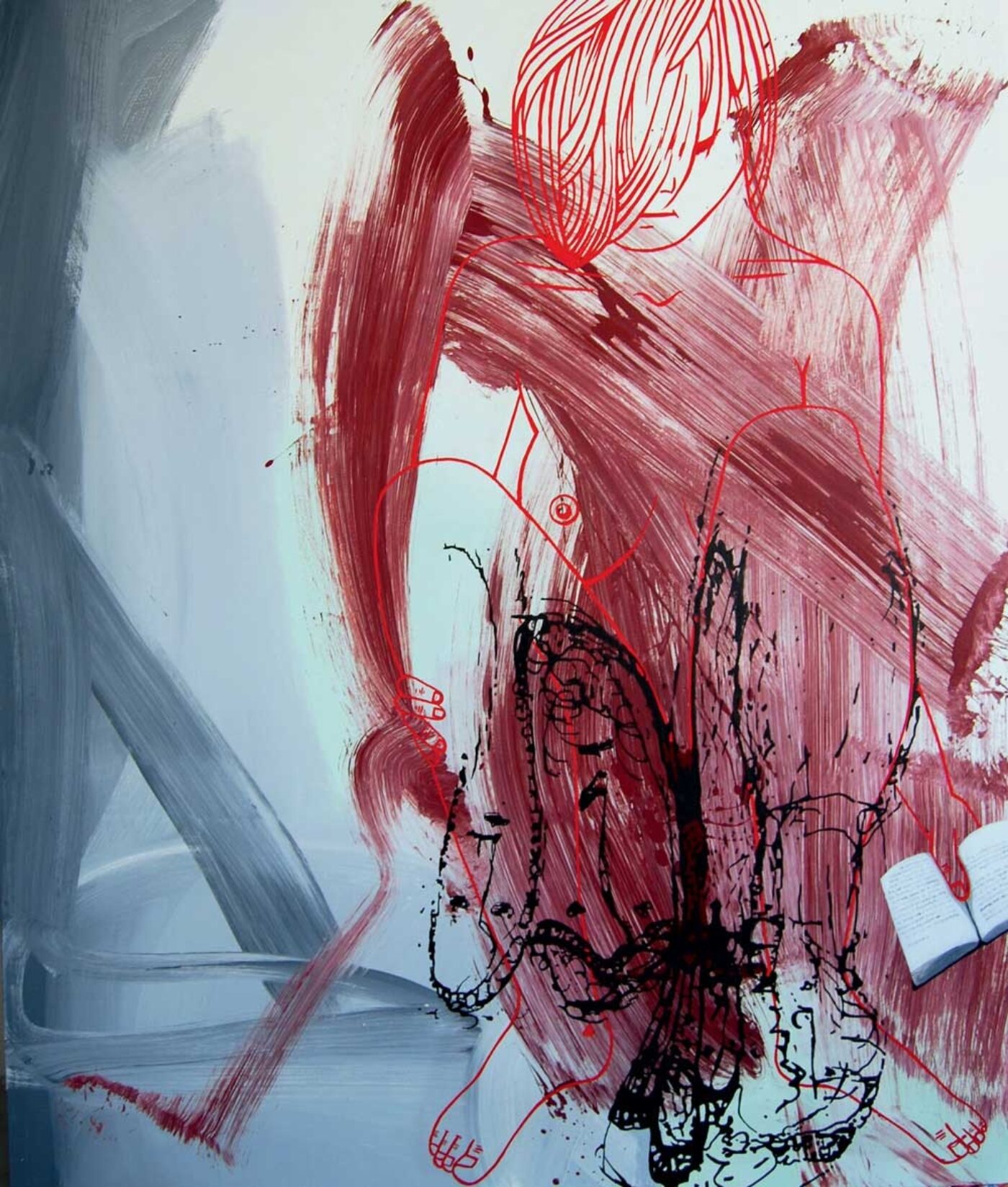
David Humphrey, Proust’s Doodle, 2014, acrylic on canvas, 72 × 60 inches. All Humphrey images courtesy of the artist, Fredericks & Freiser, and Marcia Wood Gallery, Atlanta.
David Humphrey People will say to me that it looks like I can do whatever I want in my paintings, since I pull images from my imagination, throw in media images, abstract gestures and shapes, and swerve in any direction. I’ll say, “Well, no, it doesn’t feel that way at all, but my friend Nicole Eisenman, that’s really true of her!“
Nicole Eisenman (laughter) So we all feel like the other guy has complete freedom?
DH Yes, exactly.
NE You don’t think I have “brand recognition,” as I’ve heard you call it?
DH You have total brand recognition, but it seems like you give yourself permission to exercise any kind of pictorial option, even if that means exaggeration, editorial intervention, or realism.
NE I think we both do that.
DH I believe in flexibility as an ideal, but I do tend to look longingly at other people who seem to have more of it.
NE That’s because you’re such a maker at heart. You don’t have enough time or space to make all the things you’d like to make, so other people have to make them for you. So I’m making your art for you in my studio, you’re making my art for me in your studio, and we’re all making our art for each other in our own studios.
DH I hope so. Wouldn’t that count as some kind of sub-community where there’s pictorial dialogue at a distance, without artists ever having to talk to each other?
NE It’s a mass collaboration. I honestly do think of it like that. We are all in this big project together.
DH It’s a hive structure. And maybe we’re like neurons in some kind of big brain.
NE Yeah. It’s a good attitude to adopt because it can bring the joy back to a space that can be very hard for an artist, like when seeing something you wish you had made.
DH In terms of this openness, I feel like your work, your methods, your processes, are very porous. You adapt sources, you make things up, remember images, and include all of it in the picture if it suits you. I like to think that I’m also that way, but perhaps I’m more source-driven.
NE I can be source-driven.
DH My fantasy about your drawings is that you can sit down in front of a page and cook it up—maybe from a verbal description or a memory—whereas that’s more troublesome for me. I prefer having something concrete to jump off from.
NE We both like something to react to. You like a visual diving board to push off of. For me it could be an idea I read or a phrase in a book. This past year, symmetry has come up a lot. I built those pieces in the MoMA painting show [The Forever Now: Contemporary Painting in an Atemporal World] around it. That’s enough of an idea for me—just dropping a line down the middle of a page and building off of it and seeing what shapes begin to evolve.
DH I think that the logic of faces underlies your strategy.
NE What is the logic of faces?
DH It’s kind of a glyph. That face-like painting over there (points to the wall) looks like the floor plan for a game or a sport that we don’t know the rules of yet.
NE But we do know the rules of faces, we absorb them subconsciously.
DH Isn’t the face the primordial, symmetrical space that one peers into or that one projects from? The first object of attachment, and of looking?
NE It’s the site of emotional learning. I return to the face again and again, but it’s also the relationship that is primordial—everything happens between two bodies.
DH Yes, between two bodies or two faces. Think of babies. When they emerge, they seem to have a special preoccupation with faces. All the rewards of nourishment and care come from their ability to navigate faces.
NE It’s true that gazing into the mother’s face is crucial for brain development. Also the idea of mirroring and symmetry comes into play. Though I recall seeing somewhere that it doesn’t really matter what face you look at; it doesn’t need to be the mother, or maybe even the same species as you. All you need are eyeballs and an expression.
DH You also have to be cute enough to be looked after, because you’re so helpless as a baby. Someone’s got to take care of you, otherwise you get pruned out of the system.
NE Being cute helps in almost every context.
DH Something we share, but that you really dig into, has to do with the relationship between individuals and groups. The psychological space between people is like the space between a painting and a spectator, but then you expand that space to constitute collectives, tribes. Sometimes they’re waiting for the subway, as in that painting over there (points to a work), or they’re at a biergarten, or hanging out around the privacy of a table. This is a really interesting subject that doesn’t get a lot of play in contemporary art—the resonance of an individual person within the pack.
NE I think of Canetti’s Crowds and Power and the ecstatic murals of Michelangelo. It doesn’t really matter what the group is doing—what’s interesting is the single body, separate and part of this assemblage.
DH I’m picturing an idealized pleasure space, a space of contact and relaxed boundaries.
NE And power. It’s a place where the individual ego dissolves and total permission is granted to do anything and act in any way.
DH I guess it’s not quite you in the sense of the person sitting in front of me. It’s a you that’s been slurred—
NE —a you that dissolves into a rhythm.
DH Do you think of family as a tinier, more prickly, and difficult group that’s on a continuum between the solitary individual and the horde?
NE What happens in families is that we’re trying to put our own egos forward and individuate, and we’re pushing up against this small pack of people who are basically trying to kill us.
DH Especially if they love you.
NE A mob is the inverse of that. Total permission is granted to not be a creature of ego.
DH It has ecstatic potential. Families are never ecstatic—oh my God, they’re the opposite.
NE What is the opposite of ecstasy?
DH Some kind of implosion. (laughter)
NE Emotional nitroglycerine! Your work is right in the middle of that. It continually comes back to the pairing of bodies and what can happen in the space. It can be a completely liberating and egoless experience to be part of a couple, or it can kill
you.

Nicole Eisenman, It Is So, 2014, oil on canvas, 65 × 82 inches. Courtesy of the artist, Anton Kern Gallery, New York; Galerie Barbara Weiss, Berlin; and Susanne Vielmetter, Los Angeles. Photo by John Berens.
DH That’s, like, the most profound loneliness imaginable.
NE It can be. Loneliness exists in how we perceive our relationship to others.
DH That is the developmental drama of beginning one’s life as a deeply, radically unsingular entity and navigating, or constructing, or having forced upon you, a singularity that always has a trace of its undifferentiated origins.
NE What a certain Viennese psychoanalyst told us is that we are always seeking to reconnect. It’s a pain in the ass.
DH A real pain in the ass.
NE In the future this won’t be an issue, when everybody is born from a test tube or something, and we won’t have to be searching for the comfort of the womb the rest of our lives.
DH Our paintings won’t be as good under those conditions, though.
NE Yes! Strife feeds the beast, though more and more I need to be in a good, comfortable, and balanced mindset to be productive. When personal stuff is hard, it takes up too much thought space. Do you feed off of the hard stuff?
DH Well, I suffer, and I don’t really enjoy painting under those conditions, but the work turns out to be just as good, which is very confusing.
NE As long as you keep working, it’s okay. All that emo stuff finds its way into the
work. It only becomes problematic when that jizz jazz interferes with process.
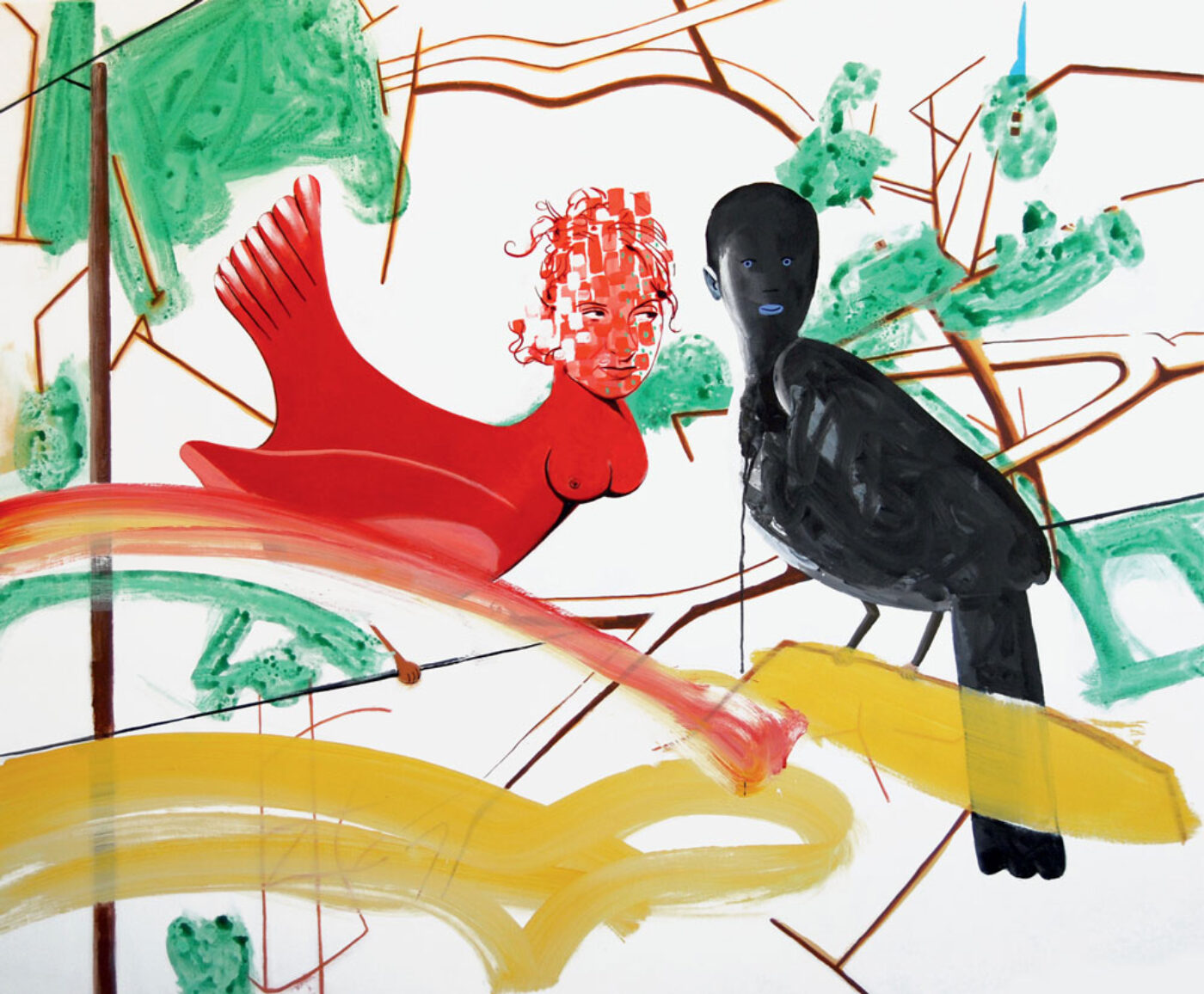
David Humphrey, The Birds, 2013, acrylic on canvas, 60 × 72 inches.
DH You were saying earlier that somehow content leaks into your work without you actually willfully putting it in. I feel that way too. I guess it comes from listening to instincts, impulses, and intuitions with the faith that somehow your decisions are going to mean something eventually. In the process of working something will emerge—almost always an aspect of yourself that you weren’t conscious of.
NE Yeah, it’s not even subconscious. It’s down there below that. Your brain allows you little peeks into your subconscious via dreams. But what filters into painting is like sub-subconscious. You don’t know it’s there until you’ve painted it and, even then, it can take years to understand and see what’s there. I think you are right to use the word faith.
DH I believe it was Christopher Bollas who talked about the “unthought known.” The knowledge is in there, but you haven’t gotten around to thinking it.
NE The “unthought known”—that’s great.
DH Certain kinds of painting are a good place to exercise these occluded states of mind. There’s something about the physicality of it too. Your paintings are emphatically touched. Your hands are all over them, even though they’re complicated hands. Sometimes they’re very sensitive and thoughtful; other times they come punching in, maybe delivering slaps.
NE Who doesn’t enjoy a loving slap every now and then? What do you think about texture? You arrive at a surface that says something about the world we live in. Your surfaces circle back to the idea of artifice; there is a quality of silk or ice—like, my eyes slip around when I look at your paintings.
DH I want to make painting that has a kind of skin, with a history. It’s got some scars and bruises; you can feel that there’s something behind it. At the same time, I never build it up so much that I can’t adjust colors and shape locations. There’s a certain textural evenness that is a result, but which sustains the possibility that I can move an image an inch to the left, or change it to green, without having to fight the ghost of what was there before.
NE There is a liquid quality to your paintings’ surfaces; they’re smooth and milky.
DH (laughter) That’s satisfying.
NE I can have moments of milkiness, but I have more moments of awkward weirdness.
DH Jennifer [Coates] and I have a painting of a head in our apartment that you gave us because you hated it so much.
NE Oh yeah, that silver head.
DH It’s got skin problems.
NE Yeah, it does. (laughter)
DH Maybe you were punishing somebody in that one.
NE Probably! But mostly it’s about putting shit on the canvas and looking at texture. I made it at the beginning of 2004 or 2005, when I was starting to push the sculptural quality of oil paint.
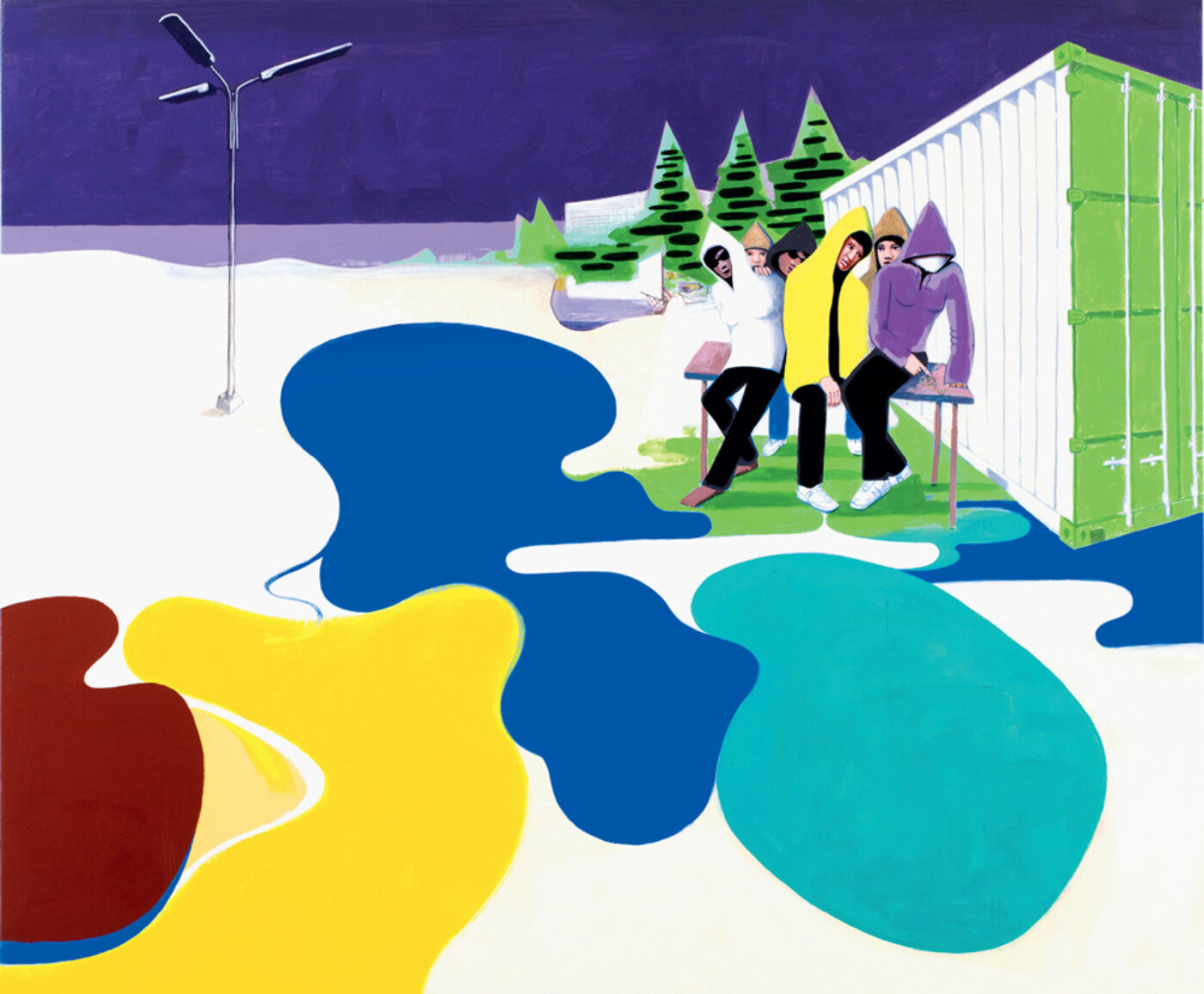
David Humphrey, Hoodies, 2011, acrylic on canvas, 60 × 72 inches. Private Collection, Courtesy Fredericks & Freiser, NY.
DH So was it something to resist or something that enhanced the image? How did it function for you?
NE The surface becomes more important than the image. The image is slippery; it doesn’t matter what it is. There’s something under the image—a quality of pattern and texture—that’s the heart of the painting. It’s almost impossible to get it in a photograph.
Painting needs to be seen in real life. I’m never happy with how it photographs because the struggle, the touch of the artist, goes missing. It’s amazing when you go to the Metropolitan Museum and you look at something like Van Gogh’s sunflowers. Isn’t it astonishing, that painting? This is such an obvious, dopey thing to say. But you can look at Van Gogh’s paint marks and almost shake his hand. As a painter, you have this mirror neuron thing that starts ricocheting around; you become Van Gogh standing in front of his painting.
DH The time between then and now snaps shut; there’s no loss of resolution. The paint dried. It was wet for a while and then it dried for Van Gogh more or less as we see it now.
NE And whether he made it or I made it, it doesn’t matter. Somebody in our human race made it. We all kind of made it and it belongs to all of us. I get these feelings of oneness with all people. It’s deep and wonderful and then I start crying. (laughter)
DH Oh, Nicole, I’m going to cry now.
NE Dude, it’s profound! The connection is via texture, not image. Image is all up here, above your neck, in your brain. Texture is all below your neck and about your body and how your gut feels. I don’t know how those mirror neurons work, but I know we have brain cells in our stomach—it feels like it’s from there that deep empathy and an understanding of painting comes.
DH There might be some neurons like six inches below the stomach, too.
NE Yeah, down around the anus. I’m very smart down there.
DH Yes, neural activity is a lot dumber on the front side.
What is the vicarious relation we, as artists, have to handmade images? We can feel what it was like to make the thing, especially when standing about arm’s length from it. It can be a relation of identification, to track the pressure and extent of a marking gesture. Maybe people who love sports feel that way when they watch an athlete do something.
NE I read a scientific study about couch potatoes who watch sports; they actually burn calories sitting still.
DH That’s much easier than going to the gym. Let’s talk about sculpture for a minute.
NE Oh, I know, we’re both painters who sculpt. We have some crossover with material too, because you’ve been working with plaster for ages.
DH I love it. It’s like paint: it has a liquid state that you can push around before it becomes frozen.
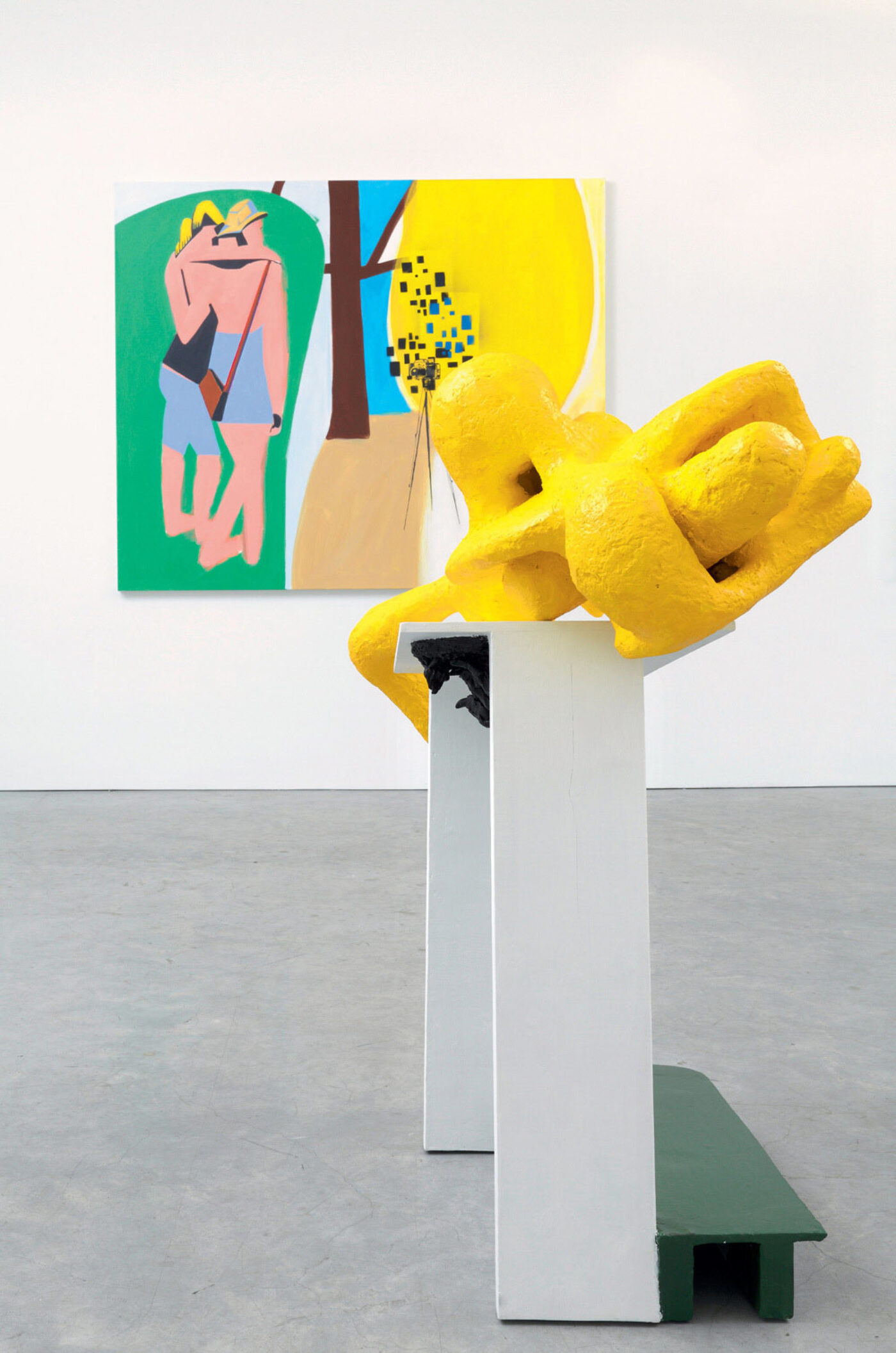
David Humphrey, Campfire, 2014, paper pulp, hydrocal, and wood, 46 × 48 × 22 inches. Installation view Fredericks & Freiser, NY.
NE Are you still doing plaster?
DH I am, but I’ve been working more with paper pulp mixed with hydrocal. I’ll build up the form with that, and then use the straight plaster as a finishing skin.
NE You use found objects in a way that is utterly brilliant and hilarious. You tear apart objects that deserve to be fucked with and mash them into a new context that makes them better. You are a kind of bricolage healer or tchotchke whisperer.
DH Maybe that’s part of the way we were talking about sources—something to push off of, a way to bring the world into the work.
NE I’ll never forget that show you did up in Harlem with those giant blow-up snowmen. You had like twenty-five giant blow-up snowmen lying on top of each other in a room.
DH It was kind of an orgy.
NE It was a dream come true.
DH I love the challenge of an occasion—a room, a duration, a budget—and just charging into it.
NE You need a grant so you can cast that entire thing in bronze and put it in Central Park.
DH Someday. I know you were stalking sculpture but then you decided to jump completely into it. Was in it London that you made the sculptures in the gallery?
NE Yeah, it was a continuation of something I started as a student at RISD with my friend Molly Bradford. We built maybe six or seven really large, full-on plaster bodies. We took over a room in the Metcalf building at RISD. We got into a lot of trouble because we made a huge mess with the plaster. They were threatening to suspend us, and they tore the pieces apart before we could photograph them. It turned out to be kind of traumatic; Molly pretty much dropped out of school after that. It was such a weird disconnect, making the best thing ever and getting into that much trouble for it. They sent my parents pictures of outlets that the fire department had taken with plaster in the sockets … I didn’t touch plaster again until a couple of years ago.
DH That’s a great origin story for sculpture.

Installation view of Nicole Eisenman’s Prince of Swords, 2013, plaster, graphite, and quartz, 2013 Carnegie International, Carnegie Museum of Art. Courtesy of the artist. Produced in conversation with Sam Greenleaf Miller.
NE What’s your origin story?
DH My dad was a Sunday sculptor who had tools and materials in the basement. There was a moment when I was ten or eleven when I had the idea of covering chicken-wire with burlap soaked in plaster. My first sculptures were these big blobby things that I like to think of as being comic-modern, like Franz West.
NE That’s so awesome, a chip off the old block.
DH Yeah, I loved it. I could always make one if I needed to show off for some reason. I went to art school at MICA, where you had to wait until the junior year before you had access to the fancy sculpture studios. I went there thinking I would make big, welded things. I had never really painted or drawn anything. In those first two years, though, I fell in love with the odd discipline and freedom of drawing and painting. I was seduced.
NE Wow, that’s nice; you moved toward the new and unknown.
DH Art school stories.
NE Your sculpture seems to slide seamlessly into paint space and vice versa.
DH I guess there’s imagery in them. It’s the idea that a sculptural object can have within it the quality of a fiction, something like the way a flat picture can describe a third dimension—cowboy figurines sitting around a fire or a couple of stuffed dogs tell stories about dogs and men but also about who might have owned the original objects that I’ve conscripted. Of course, my sculptures are emphatically in the room with you, and relate to furniture and architecture.
Your sculptures tend to be figures, right? My favorite moment with your sculpture was at the 2013 Carnegie International, where they were in a large atrium comingling with classical statues.
NE They were all there with their forefathers. It felt really good to build big, queer bodies and put them on pedestals next to bodies that are the standard bearers of Western form.
DH They were scruffy, bohemian great-great-grandchildren of those gods.
NE The classical Greek sculptures that dotted the room around my pieces felt like utter fiction to me. My lumps of plaster actually reflected some truths about messy and misbehaving bodies in the world.
DH We’ve learned a thing or two about flawed character and the beauty of stinkiness. I’m thinking about humor, or the burlesque, or—what is it?—the hyperbolic, in relation to your work, and maybe mine a little.
NE Yeah, putrid humor.
DH I am happy if I can make a painting that causes me to crack up or say, What the fuck is that? It happens rarely but it does happen occasionally.
NE Your work has gotten funnier. When I first encountered it, it was heavier. I assume you were putting out some very personal stuff—the themes were family and mother.
DH I imagined it being funny but nobody else thought so.
NE It wasn’t. I’m sorry. (laughter) There was some irony, which isn’t necessarily funny.
DH It’s almost never funny.
NE Maybe I’m remembering it wrong. It seems like you’re on a trajectory toward humor. I’ve stood in front of your work and chuckled. I’m on the opposite trajectory. I started off funny and I’ve completely lost my sense of humor.
DH I disagree. How can anybody have any perspective on their own humor?
NE You know when you’re being funny.
DH I’m looking at this painting of people on a train. One person has got a laptop that seems to cover and substitute for his or her crotch. It’s a skewed elaboration of self-touching.
NE That’s hot. What a read!
DH And then there’s this other person absorbed into looking out the window. That person is not only in their own world, but exists in another mode of representation, in a reality that’s focused only on looking, causing the eyeballs to grow monstrously large. And then there is the sleeping person, cut off, in yet another autonomous consciousness.
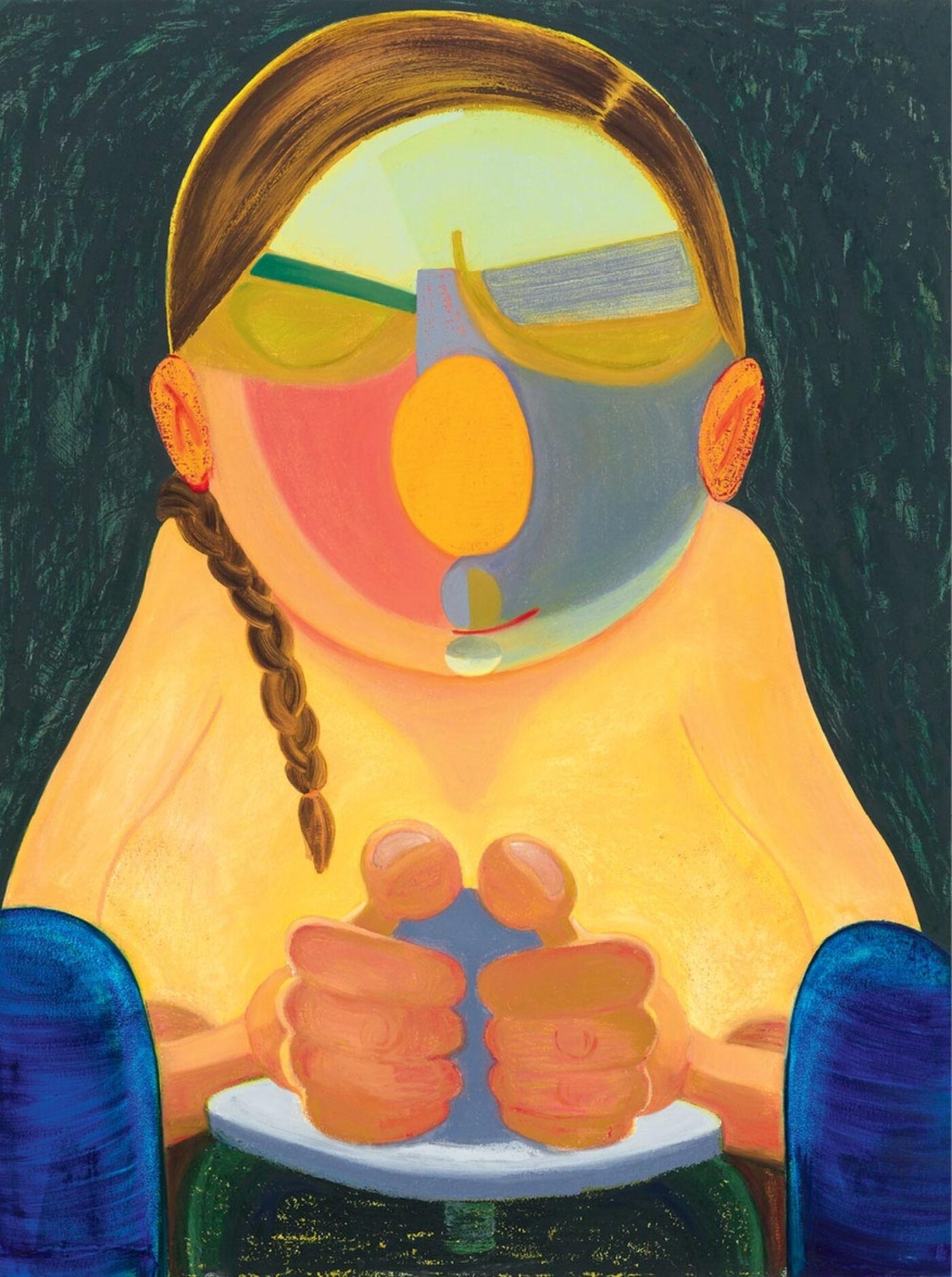
Nicole Eisenman, Northern California Potter Woman, 2015, oil on canvas, 56 × 43 inches. Courtesy of the artist and Anton Kern Gallery, New York.
NE Yeah, there is a little humor in that, I guess. The giant eyeball is kind of funny. Back in the day I actually made jokes.
DH I understand that. Sometimes you tell a joke at a party and say, “Okay everybody listen up, I’ve got this great joke.” Then when you tell it, everyone is obliged to laugh, because they know this is the social protocol.
NE Oy.
DH Whereas it’s much funnier when the joke slips in when you’re expecting something else, something serious.
NE When you take the conversation in an unexpected direction.
DH Right, and the expectation gets thwarted. The comic is a method of creating and diverting expectations. Your paintings always do that!

Nicole Eisenman, Guy Capitalist, 2011, oil and mixed media on canvas, 76 × 60 inches. Courtesy of Susanne Vielmetter Los Angeles Projects and the Museum of Modern Art, New York. Photo by Robert Wedemeyer.
NE You seem to use humor to offset discomfort. You set up a situation that can feel noxious and weird, like a bad dream. And then there’s an element that serves as the escape hatch, or a pressure-release valve. These days I’m looking for the ground underneath my feet all the time; in a way, the work I make is self-soothing. It starts out with a problem and the struggle is to feel like I’m standing on level ground by the time the painting is done. Or if it goes well, standing on top of a mountain.
DH So you can restore or correct—
NE Yeah. Maybe that’s where this new interest in symmetry is coming from. I’m looking to restore some order right now.
DH The world could use that.
NE I’ll tell you I could use that.
DH I’m remembering a moment when we were hanging out and you said to me, “Let’s make a manifesto against abstraction!”
NE That was awesome. Why did we never do that?
DH We never lived up to it. Little did we know that abstraction was going to roll in as an even bigger tide.
NE The red tide of abstraction. It’s on us.
DH I feel sucked into that tide. Abstraction is having a life in my studio that’s a little bit pernicious and hard to shake. Sometimes I’ll be making abstractions and I’ll think, How can I semiotize this? How can I ornament it or accessorize it so that it’s not abstraction? We should have written that manifesto.
NE We should have. At the moment, it was important. We felt, as figurative painters, in defensive mode. I’ve often felt like a second-class citizen in the art world because I represent bodies. I’ve felt that up until really recently—like yesterday, or something.
DH I know sometimes I feel like a dork compared to, say, research-based social practices and theoretically irradiated reductive work.
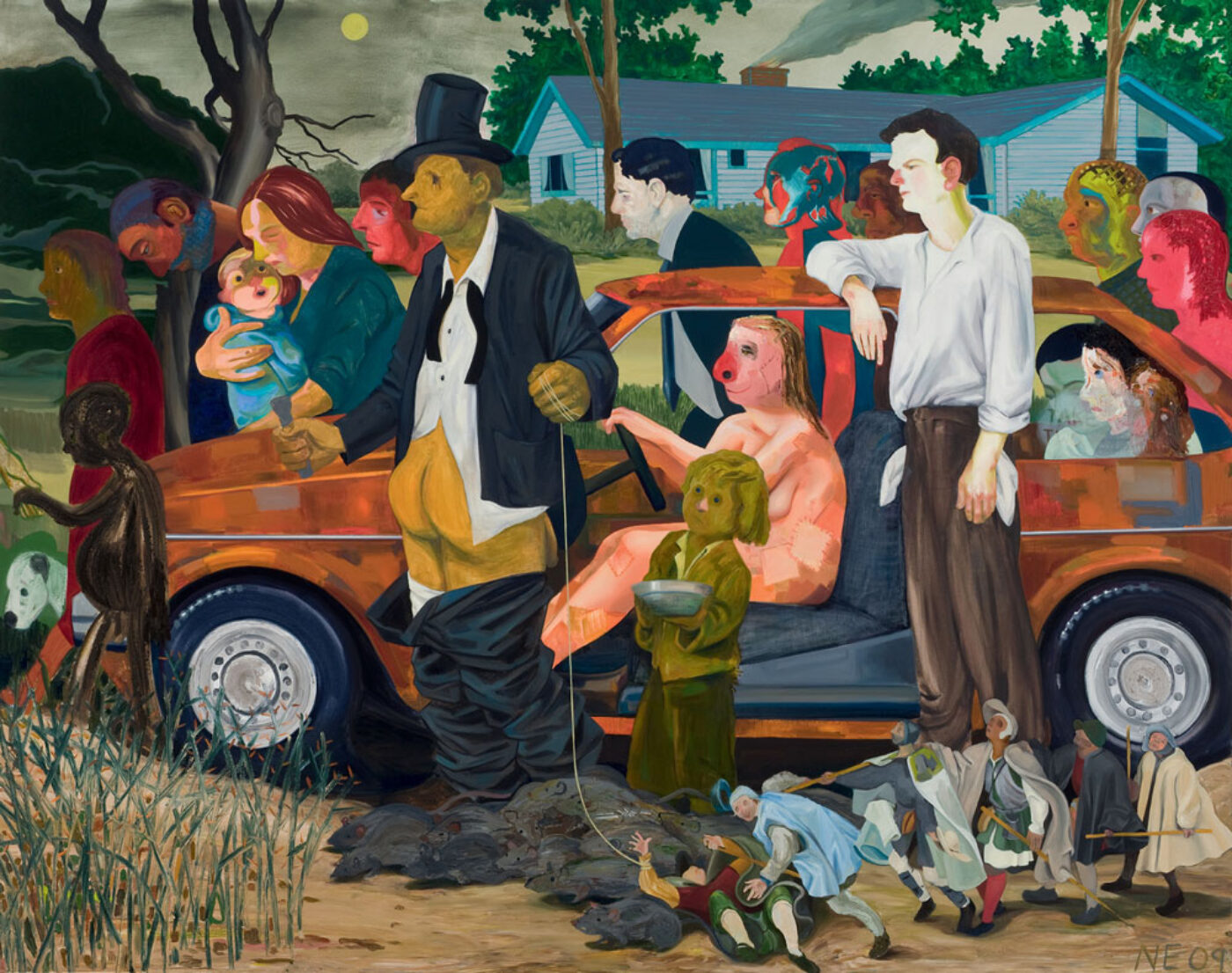
Nicole Eisenman, The Triumph of Poverty, 2009, oil on canvas, 65 × 82 inches. Courtesy of the artist.
NE (laughter) We are dorks; it’s true. Somehow recently the art world has caught up with figurative art. Everyone caught up with us. Right?
DH It’s hard to imagine that it will ever go away.
NE It won’t. Nothing is ever going to go away at this point.
DH The Forever Now.
NE Oh God, have mercy. (laughter) This space between figuration and abstraction is an interesting borderland. There are certain artists out there who have explored that line deeper than I have: Amy Sillman is the obvious example. My thing is that I’m really into narrative. It’s not about the figure—it’s the storytelling that I’m stuck on. The meat and bones in my practice is somewhere between texture and storytelling.
DH Something comes alive right when you’re trying to solve a problem in the picture. It might be: What kind of shoes are on this person? What kind of hat is that? Is that a swivel chair, is there a pattern on it? And in the aggregate of all that problem-solving you end up with a narrative that’s both bigger than, and intersecting with, the manifest narrative of people riding on a train or eating a meal or whatever.
NE Somehow what’s happening in the picture gets eclipsed by the meaning of the accumulation of those objects and moments smooshed together. You can look at how those objects and things intersect with texture and structure to deepen the story.
DH There’s the story of the labor that went into making the picture, of the behavior of the artist, let’s say.
NE See, to me, labor for labor’s sake is the least interesting thing. There’s a kind of practice where the artist will make a line, and then another line off of it, and then a line off of that line. If you keep going, eventually you have a piece of art. But who gives a darn? Labor is labor. Okay, Agnes Martin made something that way, she gets big ups.
DH Maybe the labor makes a fiction of the artist’s devotional feeling—
NE I like what your implying. I don’t know. The picture becomes nothing more then a palimpsest of an experience. It’s very self-reflexive and circular—like chasing your own tail. Some linear storytelling or disruptive event must be introduced. I want stories that happen outside of the self, outside of art practice. This is my crotchety moment.
DH Isn’t there a side of the Nicole Eisenman story in which you make pictures of people and communities that conjure a sort of homo-utopia?
NE Homo, queer, whatever, yes. But so not utopian. I am reflecting my experience of the world as I move through it. To an extent it’s about me, but I also want to reflect something that’s not about me.
DH So is the ideal that your excellent conjuring gives the picture an autonomy that thrives independently without requiring a Nicole Eisenman fiction attached to it?
NE Of course my work is independent of me, hell, I barely feel responsible for making it. But are you interested in that?
DH I’m not interested in anything that has to do with a fiction of David Humphrey at all. I do like the idea, though, that I could somehow exercise different roles inside the picture. If I make a big, giant gesture, I do it as though I were a certain kind of artist. Then I zoom out and assume another role—call it a subject position—in which I’m a rendering dufus making pictures of a chair or a person. Ultimately the picture has different characters or roles inside of it, including the depicted figures, the fiction of a person who made it, and the conventions or modes of representation being employed.
NE Fixed positions are dull and not even real. Subjectivity is super slippery.
DH It’s like acting in order to perform with clarity in the picture.
NE That sounds like fun, and stands in contrast to the kind of navel-gazing that can happen in work that only engages with process or constantly refers to itself in an endless feedback loop and thus becomes small.
DH That bothers me too. This is the problem with a lot of abstraction.
NE But then it can look “beautiful” or, better yet, cool. But it’s not enough.
DH Especially if it’s only attached to art—precursors, the history of art, and other artists. Then the work collapses into a closed-off, parallel world.
NE Maybe it’s better not to get too hung up in the conversation about what we don’t like. I’ve noticed, amongst my abstract painter friends, that they talk about their work in figurative terms. Then my figurative painter friends talk about their work’s abstract qualities. The grass is always greener …

David Humphrey, Horsey Love, 2014, acrylic on canvas, 60 × 72 inches. Collection Saatchi Gallery, London; Courtesy Fredericks & Freiser, NY.
DH I like the question, and it seems like abstraction goes into it: How does the picture hang together? What are its principles of order? Its composition? I guess that would be the old-fashioned way to talk about it. What is its disposition, its posture, or its mood? All of these questions are related and talk about the painting independent of its subject matter. That’s interesting to me.
NE Yes, that is the interesting part, and the one we’re not in control of at all.
DH Mostly. I don’t know about you, but the ideal is to have something that’s well-built but not too well-built. You want it to fall apart or be a little bit at the limits of your control.
NE Ha! Damn. I try to control it as much as I can. I set myself up for failure.
DH Symmetry is a challenge, because it risks being static—
NE Symmetry is false. Only true in the ideal. It seems like a science-y word. Maybe symmetryisn’t the right word. Mirror, or mirroring, sounds better to me. There’s a reflective quality in the image.
DH Bilaterality.
NE There are things that will throw symmetry off, but as a place to build from, it seems useful right now. Toward what ends, I don’t know.
Nicole Eisenman is a New York-based artist known primarily for her paintings. She was awarded a Guggenheim Fellowship in 1996, the Carnegie Prize in 2013, and has twice been included in the Whitney Biennial (1995 and 2012). Recent exhibitions include the 2013 Carnegie International, The Forever Now: Contemporary Painting in an Atemporal World at MoMA, and her mid-career survey, Dear Nemesis: Nicole Eisenman 1993-2013, which was organized by the Contemporary Art Museum St. Louis, traveled to the ICA in Philadelphia, and is currently on view at the Museum of Contemporary Art San Diego.
David Humphrey is a New York-based artist who has shown nationally and internationally. He has received a Guggenheim Fellowship and the Rome Prize, among other awards. An anthology of his art writing, Blind Handshake, was published by Periscope Publishing in 2010. He teaches in the MFA programs at Columbia and the University of Pennsylvania and is represented by the Fredericks & Freiser Gallery, NY and Marcia Wood gallery in Atlanta, GA.
